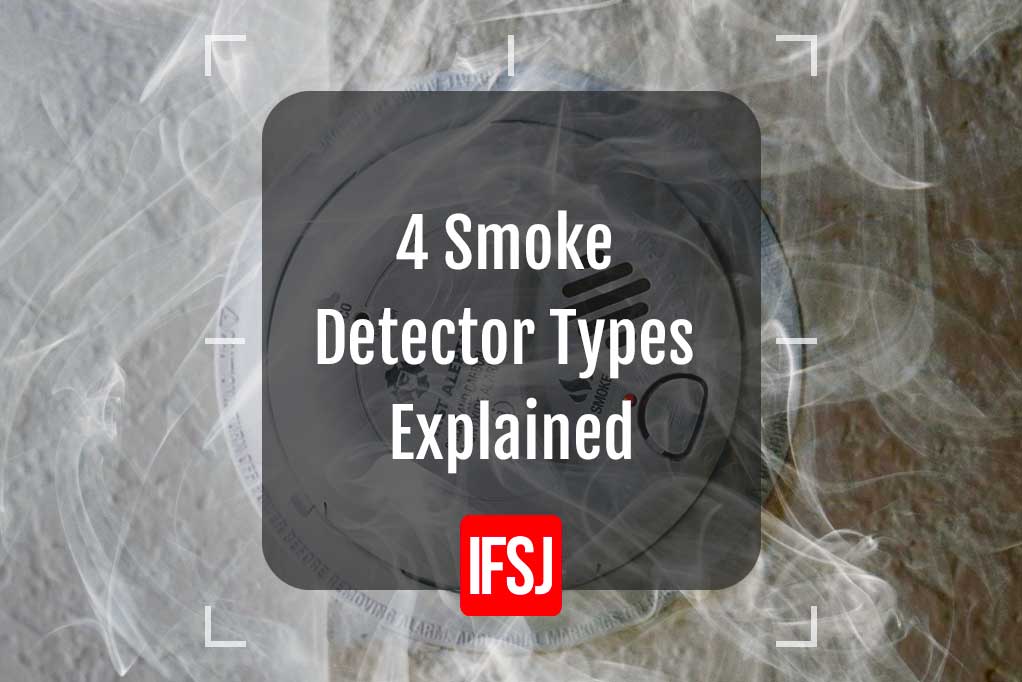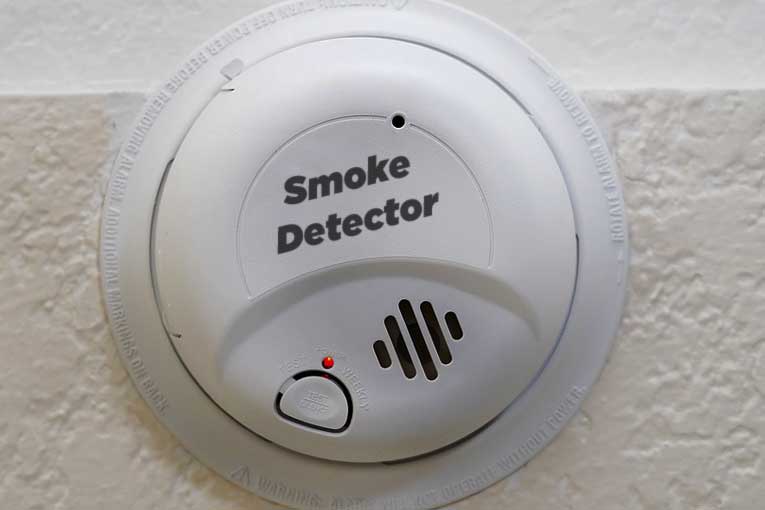4 Smoke Detector Types Explained
- December 1, 2023
- 9:00 am


Simon Burge
Share this content
In home safety, smoke detectors are always ready to alert us to potential dangers.
However, not all smoke detectors are created equal.
There are different types, each designed for specific purposes.
In this article, we’ll unravel the mystery of smoke detector types, explaining their functionalities, strengths, and ideal applications.
Understanding these variations is crucial for ensuring the safety of your home and loved ones.
Why are there Different Smoke Detector Types?

You might wonder why there’s a need for different smoke detector types.
The answer lies in the varying natures of fires.
Some fires produce different types of smoke and heat, making it essential to have varied smoke detector types that sense these differences.
By having multiple types, you’re ensuring a higher chance of early detection regardless of the fire’s origin.
Ionisation Smoke Detector
Ionisation smoke detectors operate on the principle of ionising radiation, utilising a small, controlled amount of radioactive material, often americium-241.
This material emits alpha particles, which ionise the surrounding air molecules in a small chamber inside the detector.
This ionisation process creates a stable electric current within the chamber.
When smoke particles enter the detector due to a nearby fire, they interfere with the electric current.
The presence of smoke disrupts the ions’ flow, causing fluctuations in the electric current.
This disruption triggers the alarm, indicating the potential presence of a fire.
Advantages of Ionisation Smoke Detectors
Swift Detection of Fast Fires
Ionisation detectors excel in swiftly detecting fast, flaming fires.
Fires that rapidly consume combustible materials produce fewer large smoke particles and more small, invisible particles.
Ionisation detectors are highly sensitive to these smaller particles, ensuring prompt detection and alerting occupants promptly.
Cost-Effectiveness
Ionisation detectors are generally cost-effective, making them accessible for residential and commercial use.
Their affordability allows for widespread adoption, enhancing overall fire safety in various settings.
Commonly Used in Living Spaces

These detectors one of the most common smoke detector types in living rooms, bedrooms, and hallways, where typical combustible materials like fabrics and paper are present.
Their ability to quickly detect fast-burning fires makes them valuable in spaces with these materials.
Disadvantages of Ionisation Smoke Detectors
Limited Sensitivity to Slow Fires
Ionisation detectors might not be as sensitive to slow-burning fires, such as smouldering electrical fires.
In scenarios where the fire generates more significant smoke before escalating, ionisation detectors might not provide as early a warning as desired.
Potential False Alarms
In areas like kitchens, where cooking activities can produce steam or minor smoke, ionisation detectors are prone to false alarms.
This limitation requires careful placement to avoid unnecessary disruptions.
Radioactive Material Concerns
While the radioactive material used is minimal and safely enclosed, some individuals might have concerns about the presence of any radioactive substance within their homes, even in minute quantities.
Heat Smoke Detector
Unlike traditional smoke detectors, heat smoke detectors operate on a different principle.
Instead of sensing smoke particles, they respond to temperature changes.
Inside a heat detector, there’s a thermal sensor or a thermistor that continuously monitors the surrounding temperature.
When a significant and sudden rise in temperature occurs, indicating the presence of a fire, the heat detector triggers the alarm.
Advantages of Heat Smoke Detectors
Specific Response
Heat detectors respond only to significant temperature increases, making them immune to smoke, steam, or minor heat fluctuations.
This specificity makes them ideal for places like kitchens, garages, or workshops, where false alarms from cooking activities or exhaust fumes can be common with traditional smoke detectors.
Reliability in Harsh Environments
Heat detectors are highly reliable in harsh environments where smoke detectors might malfunction.
Areas with high dust, moisture, or drastic temperature changes, which could interfere with the operation of traditional smoke detectors, make heat smoke detectors the prime choice for smoke detector types in these conditions.
Complementary Protection
They provide an additional layer of safety when used alongside traditional smoke detectors.
By detecting temperature changes, they offer a backup alarm system, ensuring that fires are detected even if smoke detectors fail to respond due to specific conditions.
Disadvantages of Heat Smoke Detectors
Lack of Early Warning
Heat detectors do not offer early warning signs of a fire.
They respond only when a fire has already generated a substantial amount of heat.
This delay in detection can be a disadvantage, especially in situations where early detection is critical for evacuation and fire control.
Not Suitable for All Areas
While excellent for specific environments, heat detectors are not suitable for areas where early detection of smouldering fires or small flames is essential, such as bedrooms or living rooms.
In these spaces, smoke detectors are more appropriate.
Limited Applicability
Heat detectors are specialised devices suited for specific situations.
They cannot replace the versatility and broad application of smoke detectors, making them a supplementary rather than a primary fire detection method.
Optical Smoke Detector
Optical smoke detectors, often referred to as photoelectric smoke detectors, rely on a straightforward yet ingenious mechanism.
Inside the detector, there’s a light source, typically an LED, and a light sensor.
The chamber between these components is designed to be free of smoke under normal conditions.
When smoke particles enter this chamber, they scatter the light, causing it to hit the sensor. This interruption triggers the alarm, indicating the presence of smoke.
Advantages of Optical Smoke Detectors
Early Detection of Smouldering Fires
Optical smoke detectors excel in detecting slow-burning, smouldering fires, which often produce more smoke than flames.
This early detection capability is crucial for timely evacuation and fire control, making them ideal for bedrooms, living rooms, and other areas where people might be asleep or unaware of a fire’s initial stages.
Reduced False Alarms
Optical detectors are less sensitive to minute particles and minor heat fluctuations, reducing the likelihood of false alarms caused by cooking activities or steam.
This specificity ensures reliable detection without unnecessary interruptions, making them suitable for residential spaces where false alarms can be disruptive and concerning.
Suitable for Residential Spaces
Due to their ability to detect slow-burning fires and their reduced sensitivity to common household disturbances, optical smoke detectors are widely used in homes.
They provide reliable fire detection while minimising the inconvenience of false alarms, ensuring the safety of occupants without causing unnecessary panic.
Disadvantages of Optical Smoke Detectors
Slower Response to Fast Flames
Optical smoke detectors may respond slightly slower to fast, flaming fires compared to ionisation detectors.
While they are excellent for smouldering fires, their response time might be marginally delayed in situations where rapid flame detection is crucial.
Limited Sensitivity to Certain Particles
While reduced sensitivity is an advantage for preventing false alarms, it can also mean that in certain conditions, such as detecting very fine smoke particles, optical detectors might take longer to activate, potentially delaying the alarm in specific fire scenarios.
Not Universal for All Fire Types
Optical detectors are highly effective for specific fire types, but no single type of detector is universally perfect for all situations.
For comprehensive fire protection, a combination of different types of smoke detectors might be necessary to cover various fire behaviours.
Combination Smoke Detector
Combination smoke detectors revolutionise fire safety by integrating multiple sensor technologies within a single unit.
One common combination involves merging ionisation and optical sensors.
The ionisation sensor excels in detecting fast, flaming fires, while the optical sensor specialises in recognizing slow, smouldering fires.
By combining these sensors, the detector can swiftly identify a broad range of fire types.
When smoke particles disrupt either sensor, the alarm is triggered, ensuring rapid response regardless of the fire’s nature.
Advantages of Combination Smoke Detectors
Comprehensive Fire Detection
The primary advantage of combination smoke detectors is their ability to detect various fire types.
By integrating different sensor technologies, they provide comprehensive coverage, ensuring early detection of both fast and slow-burning fires.
This versatility makes them highly effective in diverse environments.
Reduced False Alarms
Combination detectors leverage the strengths of different sensors, making them less prone to false alarms triggered by common household activities like cooking.
Their enhanced specificity ensures that alarms are only activated when genuine fire threats are detected, minimising unnecessary interruptions.
Versatility for Different Environments
Combination detectors are versatile and adaptable, making them suitable for various settings.
They are commonly used in homes, where different fire scenarios can arise, ensuring that residents are safeguarded from a wide range of potential threats.
Disadvantages of Combination Smoke Detectors
Complexity in Maintenance
Due to their multifaceted design, combination smoke detectors can be more complex to maintain and troubleshoot.
If one sensor malfunctions, diagnosing the issue might require specialised knowledge, potentially leading to challenges in repairs or replacements.
Higher Initial Cost
Combination detectors, equipped with advanced sensor technologies, often come at a higher initial cost compared to single-sensor counterparts.
While the investment provides comprehensive fire protection, it’s crucial for consumers to weigh this against their specific safety needs and budget constraints.
Power Consumption
Combination detectors, due to their dual-sensor configuration, might consume slightly more power than single-sensor models.
While the difference is usually minimal, it’s essential to consider power efficiency, especially in areas where battery life is a critical concern.
Which Smoke Detector Type Should You Use?

Selecting the appropriate smoke detector for your home involves thoughtful consideration of its layout, the activities conducted in different areas, and the potential fire risks unique to each space.
Here’s a detailed guide to help you make an informed choice:
Kitchen and Cooking Areas
Best Choice: Heat Detector
Kitchens are prone to false alarms due to cooking activities.
Heat detectors, which respond to a rise in temperature rather than smoke, are ideal here.
They won’t trigger unnecessarily due to cooking fumes or burnt toast, ensuring reliable performance in this high-risk zone.
Bedrooms and Living Spaces
Best Choice: Optical Smoke Detector
Bedrooms and living rooms often experience slow-burning fires, such as those caused by faulty wiring or smouldering fabrics.
Optical smoke detectors, sensitive to the visible smoke particles in slow-burning fires, are well-suited for these areas.
They offer reliable performance and are less prone to false alarms caused by common household activities.
Hallways and General Areas
Recommended Choice: Combination Smoke Detector (Ionization + Optical)
Hallways and general areas can experience a variety of fire scenarios.
A combination smoke detector, integrating both ionisation and optical sensors, ensures comprehensive coverage.
These detectors can quickly detect both fast, flaming fires and slow, smouldering fires, making them ideal for spaces where diverse fire risks exist.
Entertainment or Workshop Spaces
Best Choice: Combination Smoke Detector (Ionization + Heat)
Spaces like entertainment rooms or workshops might have a mix of fast-burning materials and potential heat sources.
A combination smoke detector that combines ionisation for fast fires and heat detection for abrupt temperature changes provides effective protection in these environments.
Strategic Placement for Enhanced Protection
Beyond selecting the right type of smoke detector for specific areas, strategic placement is vital for maximum effectiveness:
Install smoke detectors in every bedroom, outside each sleeping area, and on every level of the home.
Place detectors high on walls or ceilings as smoke rises.
Avoid placing detectors near windows, doors, or ducts where drafts might interfere with their operation.
Regularly test smoke detectors to ensure functionality.
By tailoring your choice of smoke detectors based on the unique needs of each space and strategically placing them throughout your home, you create a comprehensive safety net against potential fire threats.
Remember, a well-planned smoke detector setup can significantly enhance your home’s overall safety and provide invaluable peace of mind.
Conclusion
Understanding the nuances of all smoke detector types is paramount.
By tailoring your choice to the specific requirements of different areas in your home, you’re ensuring a robust safety net against potential fires.
Remember, the best protection comes from a combination of these detectors, strategically placed to detect various types of fires promptly.
Investing in the right smoke detector types is not just about adhering to safety regulations; it’s a proactive step towards safeguarding what matters most – your family and home.

